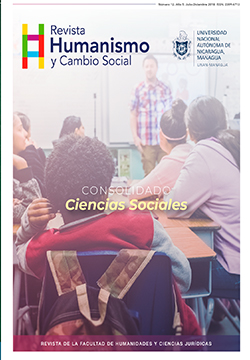The indigenous communities of Jinotega: resistance and belonging
DOI:
https://doi.org/10.5377/hcs.v0i12.8825Keywords:
Oral history, cultural identity, pervivence, territory, indigenous, indigenous communityAbstract
The object of study is to understand the elements of the Indigenous Community, a social group that self-identifies as heirs of the Chorotega indigenous culture and who are currently settled in the department of Jinotega. The study of ethnic groups represents a valuable accumulation of knowledge and traditional knowledge that have been preserved in the memory of the population through oral transmission, that is, from the myth it has been possible to keep the history of their ancestors alive. In this sense, this article is aimed at exposing the results that have been generated from that direct contact with the population, where Oral History as a method, technique and source represents the most important tool to rescue that past that remains active among the inhabitants.
Downloads
2402
References
• Guerrero J, y Soriano, L. (1967) Monografía de Matagalpa. Managua, Nicaragua.
• Membreño, M. (1998) La estructura de las comunidades étnicas. Itinerario de una investigación teórica desde Nicaragua. Editorial Envío. Abril, Managua, Nicaragua.
• Pérez, F. (1956) Las Comunidades indígenas en Nicaragua. Universidad de San Carlos: Guatemala.
• Romero, J. (Coordinadora) (2005) Región Norte Central de Nicaragua, Matagalpa y Jinotega a través de su historia. UNAN: Nicaragua.
• Romero, J. (Coordinadora) (2009) Nuestras Comunidades: Una mirada histórica a los pueblos indígenas del Pácifico, Centro y Norte de Nicaragua. UNAN: Nicaragua.
• Romero, J. (Coordinadora). (2008) Memoria e Historia de un Proyecto Social. Trabajar el presente para construir el futuro, UNAN-Managua, Nicaragua
• Romero, J. (Coordinadora). Abriendo Surcos. Memoria de actividades de capacitación llevadas a cabo en el municipio de Jinotega, mayo-agosto 2005. UNAN-Managua, Nicaragua.
• Romero, J. (Coordinadora). La madre tierra a flor de piel. Memoria e Historia de un Proyecto Social. Diciembre, 2007, UNAN-Managua, Nicaragua.
• Romero, J. (Coordinadora). Memoria e Historia de un Proyecto Social. El trabajo en el pueblo indígena de Jinotega. Diciembre, 2006, UNAN-Managua, Nicaragua.
• Romero, J. (Coordinadora). Ya estamos construyendo el futuro. Memoria e Historia de un proyecto social. Managua, UNAN, 2009.
• Wheelock, Jaime. (1981) Raíces indígenas de la lucha anticolonialista en Nicaragua). Editorial Nueva Nicaragua: Nicaragua.
Fuentes orales
• Luis González Torres (González, L). Entrevista individual realizada por Marvin Villalta en ciudad Jinotega el 16 de mayo de 2016.
• Luz Marina Herrera (Herrera, L) Entrevista individual realizada por Ruth González García en comunidad indígena de Las Cureñas, Jinotega, el 27 de octubre de 2016.
• José Luis González (González, J) Entrevista colectiva realizada por Ruth González García en ciudad Jinotega el 28 de octubre de 2016.
• Herman Osegueda Altamirano (Osegueda, H) Entrevista colectiva realizada por Ruth González en Ciudad Jinotega, el 28 de octubre de 2016.




